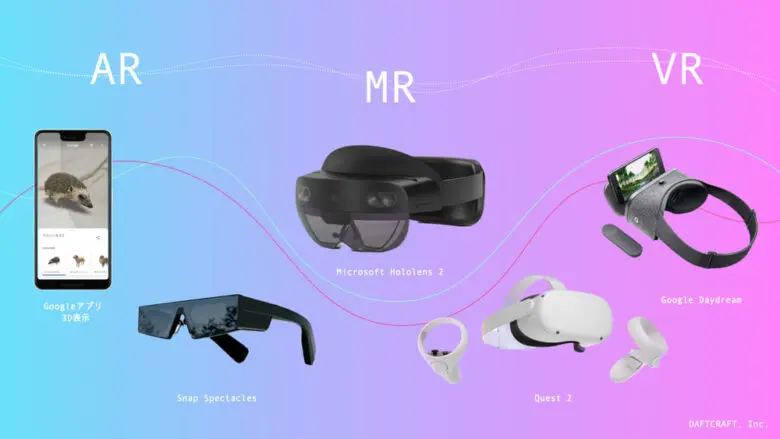WHAT IS MR? [MR Explanation 2022]

Hello! This is Ota from Daft Craft.
MR (Mixed Reality) is the second most popular technology after AR and VR when talking about XR.However, compared to AR, which anyone can easily experience with a smartphone, and VR, which is widely used as a game console, there are few opportunities to experience what MR is really like. For this reason, I think there are many people who still don’t know the details of MR.
So, in this article, let me introduce What MR is, and differences between AR/VR and MR!
What is MR?
MR, called “Mixed Reality” or “Mixed Reality” in Japanese, is one of the XR technologies. It is specialized in scanning the real world and displaying the virtual world to match its shape.
A typical hardware device is Microsoft’s Hololens series, the latest of which is Hololens 2, released in 2018. Other MR-compatible devices are Magic Leap, Canon’s MREAL, HTC’s cosmo xr, and Varjo’s XR-3.
While Microsoft’s Hololens 2 displays the virtual world in the form of a hologram, Varjo’s XR-3 displays the virtual world in the form of a video pass-through (video see-through). However, the concept of displaying the virtual world to match the real world is the same for each device.
How is MR different from AR and VR?
To put it simply, MR is not “completely different from AR and VR,” but is a technology that “has elements of both AR and VR. Also, the boundaries that distinguish it from AR and VR will likely to become more and more vague in the future as the respective hardware evolves.

As the name “mixed reality” shows, MR is a mixture of the real and the virtual. In the case of Hololens, a sensor built into the headband measures the shape of the space or room the user is in, and displays virtual reality accordingly. In addition, the virtual reality is visualized by holograms projected on the lenses, allowing the user to see the real world through virtual lenses, just like sunglasses.
In other words, it can be said that the real and virtual worlds are “combined” in two ways: (1) the spatial shape of reality is reflected in the virtual space, and (2) the real and virtual worlds are seen overlapping each other.
But in fact, AR and VR devices that can fulfill the above two points are also starting to appear.
In the case of AR, the “Spectacles 4” AR glasses announced by Snapchat’s Snap Inc. can detect the road surface using the camera on the outside. Also in smartphone AR, LiDAR, an iPhone equipped with a depth sensor, has recently been released, and there is also technology that uses AI image recognition technology to detect spaces such as walls, floors, and the sky. In this way, a way to easily grasp the spatial shape of reality is being developed.
In the case of VR, the Quest 2 VR device has a pass-through feature that allows you to virtually see the real world in real time through the camera on the outside of the device. Using the pass-through function, you can have a combined real and virtual experience, such as displaying the keyboard of a real desktop PC while using a virtual monitor of the desktop PC.
As you can see, the MR concept of capturing the space of the real world and combining it with the virtual world is increasingly being realized in various forms and methods as hardware such as smartphones and VR HMDs evolve. This is why we can expect the boundaries that distinguish MR, AR, and VR to become increasingly blurred in the near future.
Examples of how MRs are used
Now, in what kind of situations will MR be used? Let’s take a look at some of the MR devices that are currently on the market and introduce some practical examples.
1) Hololens 2 / Released in November 2019
More than two years after its release, Microsoft’s Hololens 2 still has a strong presence among MR devices. It features holographic visualization and comfortable mobility.
https://www.iatecps.com/hololens-2
For example, at a construction site, it is possible to view the buildings that are to be built at the site in their original location and size. Rather than checking the building through a tablet or smartphone, you can get a more realistic sense of depth and distance as you approach or move away from the building, making it easier to imagine what it will look like when it is completed.
2) Varjo XR-3 / Released in July 2021
The Varjo XR-3, the latest MR device just released last summer, features video pass-through visualization and extremely realistic resolution and viewing angle.
What you definitely want to experience with a device like the Varjo XR-3 is the overwhelming realism and detail of virtual objects. You don’t have to go see large objects such as cars or objects that are only available in one place in the world. Now you can see virtual objects of the same quality as the real thing, right here and now.
So, that’s our MR guide 2022.
XR technology is constantly evolving and transforming. In the Daft Craft blog, we will continue to provide interesting and easy-to-understand information about AR, VR, MR, and the new forms of “Reality” that may increase in the future. Please keep checking back!